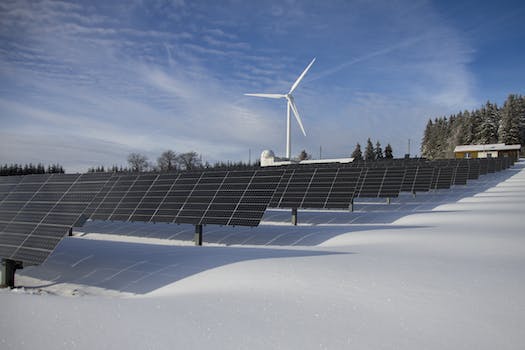-
Table of Contents
- Introduction
- The Benefits of Renewable Energy Technologies: How They Can Help Combat Climate Change
- Exploring the Different Types of Renewable Energy Technologies and Their Potential
- The Challenges of Implementing Renewable Energy Technologies in Developing Countries
- The Impact of Renewable Energy Technologies on the Global Economy
- The Future of Renewable Energy Technologies: What We Can Expect in the Coming Years
- Conclusion
“Unlock the Power of Renewables: Get the Latest Insights from nishankhatri.xyz!”
Introduction
Welcome to the nishankhatri.xyz Special Report on the Rise of Renewable Energy Technologies. In this report, we will explore the current state of renewable energy technologies, the potential for growth in the sector, and the challenges and opportunities that come with the transition to a more sustainable energy future. We will also discuss the role of governments, businesses, and individuals in driving the adoption of renewable energy technologies. Finally, we will look at the potential economic and environmental benefits of a shift to renewable energy sources. By the end of this report, you will have a better understanding of the current state of renewable energy technologies and the potential for growth in the sector.
The Benefits of Renewable Energy Technologies: How They Can Help Combat Climate Change

Climate change is one of the most pressing issues of our time, and renewable energy technologies are a key part of the solution. Renewable energy technologies offer a number of benefits that can help combat climate change, from reducing greenhouse gas emissions to creating jobs and stimulating economic growth.
First and foremost, renewable energy technologies can help reduce greenhouse gas emissions. Renewable energy sources such as solar, wind, and geothermal do not emit any carbon dioxide or other pollutants into the atmosphere, unlike fossil fuels. This means that using renewable energy technologies can help reduce the amount of greenhouse gases in the atmosphere, which is essential for combating climate change.
In addition to reducing emissions, renewable energy technologies can also create jobs and stimulate economic growth. The renewable energy industry is growing rapidly, and it is estimated that it will create millions of jobs in the coming years. This will not only help reduce unemployment, but it will also stimulate economic growth by creating new businesses and industries.
Finally, renewable energy technologies can help reduce energy costs. Renewable energy sources are often cheaper than traditional sources of energy, such as coal and natural gas. This means that using renewable energy technologies can help reduce energy costs for both businesses and households.
Overall, renewable energy technologies offer a number of benefits that can help combat climate change. From reducing emissions to creating jobs and stimulating economic growth, renewable energy technologies are an essential part of the solution. If we are to successfully combat climate change, we must embrace renewable energy technologies and make them a part of our everyday lives.
Exploring the Different Types of Renewable Energy Technologies and Their Potential
Renewable energy technologies are becoming increasingly popular as the world moves towards a more sustainable future. With the rise of climate change, renewable energy sources are becoming more important than ever. Renewable energy technologies are those that use natural resources such as sunlight, wind, water, and geothermal heat to generate electricity. These technologies are becoming increasingly popular due to their potential to reduce greenhouse gas emissions and provide clean, reliable energy.
Solar energy is one of the most popular renewable energy technologies. Solar panels are used to capture the sun’s energy and convert it into electricity. Solar energy is a great option for those looking to reduce their carbon footprint and save money on their energy bills. Solar energy is also becoming increasingly affordable, making it a great option for homeowners and businesses alike.
Wind energy is another popular renewable energy technology. Wind turbines are used to capture the wind’s energy and convert it into electricity. Wind energy is a great option for those looking to reduce their carbon footprint and save money on their energy bills. Wind energy is also becoming increasingly affordable, making it a great option for homeowners and businesses alike.
Hydropower is another renewable energy technology that is becoming increasingly popular. Hydropower uses the energy of moving water to generate electricity. Hydropower is a great option for those looking to reduce their carbon footprint and save money on their energy bills. Hydropower is also becoming increasingly affordable, making it a great option for homeowners and businesses alike.
Geothermal energy is another renewable energy technology that is becoming increasingly popular. Geothermal energy uses the heat from the Earth’s core to generate electricity. Geothermal energy is a great option for those looking to reduce their carbon footprint and save money on their energy bills. Geothermal energy is also becoming increasingly affordable, making it a great option for homeowners and businesses alike.
Renewable energy technologies are becoming increasingly popular due to their potential to reduce greenhouse gas emissions and provide clean, reliable energy. These technologies are becoming increasingly affordable, making them a great option for homeowners and businesses alike. With the rise of climate change, renewable energy sources are becoming more important than ever. Investing in renewable energy technologies is a great way to reduce your carbon footprint and save money on your energy bills.
The Challenges of Implementing Renewable Energy Technologies in Developing Countries
The implementation of renewable energy technologies in developing countries is a complex and challenging endeavor. While renewable energy sources such as solar, wind, and hydropower offer a clean and sustainable alternative to traditional energy sources, they also come with a unique set of challenges.
One of the biggest challenges is the cost of implementation. Renewable energy technologies are often more expensive than traditional energy sources, and this can be a major barrier for developing countries. Additionally, the infrastructure needed to support renewable energy technologies can be costly and difficult to install.
Another challenge is the lack of access to financing. Many developing countries lack the resources to finance the implementation of renewable energy technologies. This can be a major obstacle, as renewable energy projects often require large upfront investments.
Finally, there is the challenge of overcoming cultural and political resistance. In many developing countries, there is a lack of understanding and acceptance of renewable energy technologies. This can lead to resistance from local communities and governments, making it difficult to implement renewable energy projects.
Despite these challenges, renewable energy technologies offer a viable and sustainable alternative to traditional energy sources. With the right policies and investments, developing countries can overcome these challenges and reap the benefits of renewable energy.
The Impact of Renewable Energy Technologies on the Global Economy
The world is transitioning to renewable energy sources, and this shift is having a profound impact on the global economy. Renewable energy technologies are becoming increasingly cost-competitive with traditional energy sources, and this is driving investment in renewable energy projects around the world.
The growth of renewable energy is creating new economic opportunities for countries that are investing in renewable energy technologies. For example, countries like China, India, and the United States are investing heavily in renewable energy projects, creating jobs and stimulating economic growth. In addition, the development of renewable energy technologies is helping to reduce the cost of energy, which is beneficial for both businesses and consumers.
The growth of renewable energy is also having a positive impact on the environment. Renewable energy sources are much cleaner than traditional energy sources, and this is helping to reduce air pollution and greenhouse gas emissions. This is beneficial for both the environment and the economy, as it helps to reduce the costs associated with air pollution and climate change.
Finally, the growth of renewable energy is helping to reduce global dependence on fossil fuels. This is beneficial for both the environment and the economy, as it helps to reduce the costs associated with importing and exporting fossil fuels.
Overall, the growth of renewable energy technologies is having a positive impact on the global economy. Renewable energy technologies are becoming increasingly cost-competitive with traditional energy sources, creating new economic opportunities and helping to reduce global dependence on fossil fuels. This is beneficial for both the environment and the economy, and it is likely to continue to have a positive impact in the years to come.
The Future of Renewable Energy Technologies: What We Can Expect in the Coming Years
The future of renewable energy technologies is an exciting prospect. With the world’s population continuing to grow and the need for energy increasing, renewable energy sources are becoming increasingly important. In the coming years, we can expect to see a number of advances in renewable energy technologies that will make them more efficient, cost-effective, and accessible.
One of the most promising developments in renewable energy technologies is the emergence of solar energy. Solar energy is becoming increasingly affordable and efficient, and it is expected to become even more so in the coming years. Advances in solar panel technology, such as the development of thin-film solar cells, are making solar energy more efficient and cost-effective. Additionally, the development of solar energy storage systems, such as batteries, is making it easier to store and use solar energy.
Another promising development in renewable energy technologies is the emergence of wind energy. Wind turbines are becoming increasingly efficient and cost-effective, and they are expected to become even more so in the coming years. Advances in wind turbine technology, such as the development of larger turbines and the use of lighter materials, are making wind energy more efficient and cost-effective. Additionally, the development of wind energy storage systems, such as batteries, is making it easier to store and use wind energy.
Finally, advances in bioenergy technologies are also expected to make renewable energy more efficient and cost-effective in the coming years. Bioenergy technologies, such as the use of biomass and biogas, are becoming increasingly efficient and cost-effective. Additionally, the development of bioenergy storage systems, such as batteries, is making it easier to store and use bioenergy.
Overall, the future of renewable energy technologies is an exciting prospect. In the coming years, we can expect to see a number of advances in renewable energy technologies that will make them more efficient, cost-effective, and accessible. This will help to ensure that renewable energy sources are able to meet the world’s growing energy needs in a sustainable and environmentally friendly way.
Conclusion
The Rise of Renewable Energy Technologies: A nishankhatri.xyz Special Report has provided a comprehensive overview of the current state of renewable energy technologies and their potential for the future. It has highlighted the various advantages of renewable energy sources, such as their cost-effectiveness, environmental friendliness, and scalability. The report has also discussed the challenges that need to be addressed in order to make renewable energy sources more widely available and accessible. With the right policies and investments, renewable energy technologies can play a major role in helping to reduce global emissions and create a more sustainable future.
















